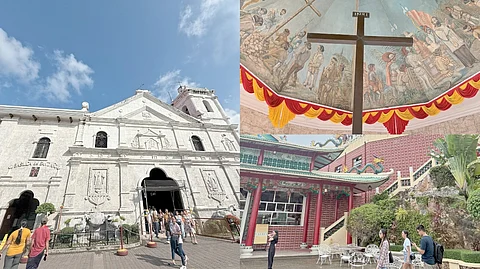
- NEWS
- the EDIT
- COMMENTARY
- BUSINESS
- LIFE
- SHOW
- ACTION
- GLOBAL GOALS
- SNAPS
- DYARYO TIRADA
- MORE

Six years. It took that long for Cebu to whisper back, “It’s time.” I didn’t want this trip to be sentimental, but it’s strange how travel can reveal more than you would have anticipated. I’m drawn to the Queen City of the South for some reason. Not with loud declarations, but with quiet gravity. You don’t ask why you keep going back. You just go.
Instagram once told me: If a place keeps calling you, there’s a reason — or a person — you’re meant to meet. I found mine. Or maybe, it found me.
This was planned to be a three-day media trip. But fate, disguised as a closed airport runway, granted me another day. Cebu gifted me with an unexpected layover and more time to explore. Because delays are not rejections; they are redirections.
I repacked my bag. Not in new clothes, but with old feelings, surprising healing, and these stops that became soul souvenirs:
Basilica Minore del Sto. Niño
Where devotion becomes palpable, and history breathes between lights and prayers to the Holy Child. I felt grounded here. The centerpiece of the yearly Sinulog event and the center of Cebu’s faith, Señor Santo Niño is home to the oldest Catholic relic in the Philippines, which Magellan gave to the city in 1521.
Magellan’s Cross
I froze under its famous pavilion. Standing in the center of our colonial memory was more than just a historical marker. The cross, which honors the start of Christianity in the Philippines, was planted by Spanish explorers in 1521 and is located next to the Basilica in Plaza Sugbo.
Taoist Temple
Panoramic views and gentle rituals reminded me to pause, cleanse, and embrace dragons’ quiet strength and devotion. Built in 1972 by Cebu’s Chinese-Filipino population, this temple commemorates Taoist philosophy with rites, green dragons, and vistas from 110 meters above sea level.
Fort San Pedro
Crumbling but proud, much like all of our revolutions. It reminded me that ends lead to new beginnings. Miguel Lopez de Legazpi erected the country’s earliest triangle bastion fort in 1565, and it was eventually converted into a stone fortress during Spanish occupation.
Yap-San Diego Ancestral House
Love, heritage and the blending of cultures that molded us were all whispered in every coral stone. A heritage home becomes soul reminder. This ancestral mansion, one of the first of its sort outside of China, was built between 1675 and 1700 by a Chinese merchant and his wife. It combines Spanish and Chinese design.
I wasn’t expecting to feel this much. Six years have passed, and the Queen City of the South still seems like home. It transported me back not only to a place, but also to a part of myself I hadn’t seen in a long time.
